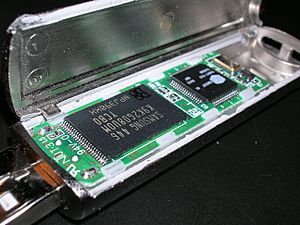Flash memory facts for kids

Flash memory is a special type of computer memory. It stores information even when the power is turned off. You can find flash memory in many everyday devices. These include digital cameras, USB flash drives, and video game consoles. It was first created in the 1980s, building on an older technology called EEPROM.
Contents
How Flash Memory Works
Flash memory is different from RAM. RAM is like a temporary notepad; it loses all its data when the computer turns off. Flash memory, however, is permanent. It keeps your photos, games, and files safe without needing power. This is why it's called "non-volatile" memory.
Flash vs. Hard Drives
Traditional hard drives also store data permanently. But they are usually bigger and have moving parts. This makes them more delicate. Flash memory is much smaller and has no moving parts. This makes it very strong and perfect for small gadgets.
Flash memory is slower than RAM. But it is much faster than old-fashioned hard drives. Its small size and toughness make it a great choice for portable electronics.
Things to Know About Flash Memory
Flash memory has some great benefits, but also a few things to consider.
Cost and Lifespan
One main point is that flash memory can be more expensive than hard drives for the same amount of storage. Another important thing is how many times you can write new data to it. You can read data from flash memory as many times as you want. But there's a limit to how many times you can save or change information. Each time you write data, it's called a "write cycle."
Most flash devices are designed to handle about 100,000 to 1,000,000 write cycles. After reaching this limit, the memory might stop working correctly.
Flash vs. EEPROM
Older EEPROM memory had a similar limit on write cycles. Early EEPROM devices could only handle about 100,000 writes. Later ones improved to about a million. EEPROM is also more expensive than flash memory. Because of this, it's rarely used for storing large amounts of data.
The main difference between EEPROM and flash memory is how they erase data. Most EEPROM devices can erase just one small piece of memory, called a "byte," at a time. Flash memory, however, can only erase a whole "chunk" or "sector" of memory at once. If you want to change just one byte in flash memory, the whole sector must be erased and then rewritten. This means flash memory can wear out a bit faster than EEPROM if you are constantly changing tiny bits of data.
Today, flash memory can store huge amounts of data. Some devices hold hundreds of gigabytes or even terabytes of information. Many common devices, like USB pen drives, use flash memory.
Where Flash Memory is Used
Flash memory is used in many different devices:
- USB flash drives (also known as pen drives)
- Solid-state drives (SSDs) in computers
- Sometimes in computer RAM (though not commonly as the main RAM)
- Hybrid drives (which combine a small SSD with a hard drive)
- Graphics cards
- Memory cards for phones and cameras
Related pages
Images for kids
See also
 In Spanish: Memoria flash para niños
In Spanish: Memoria flash para niños






